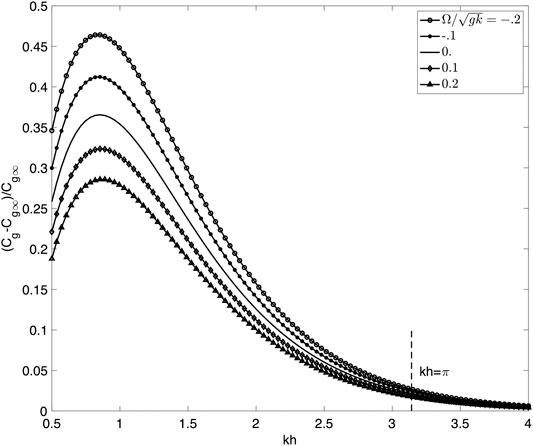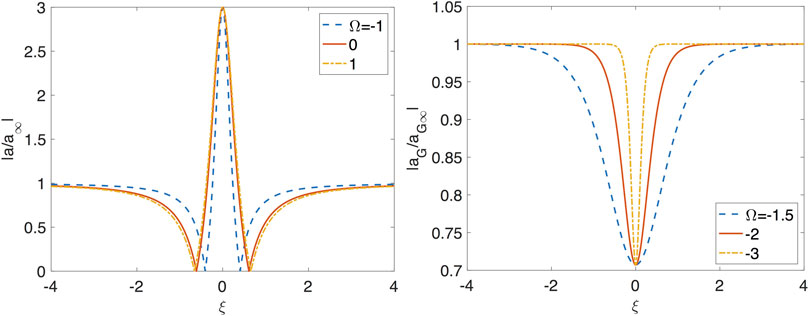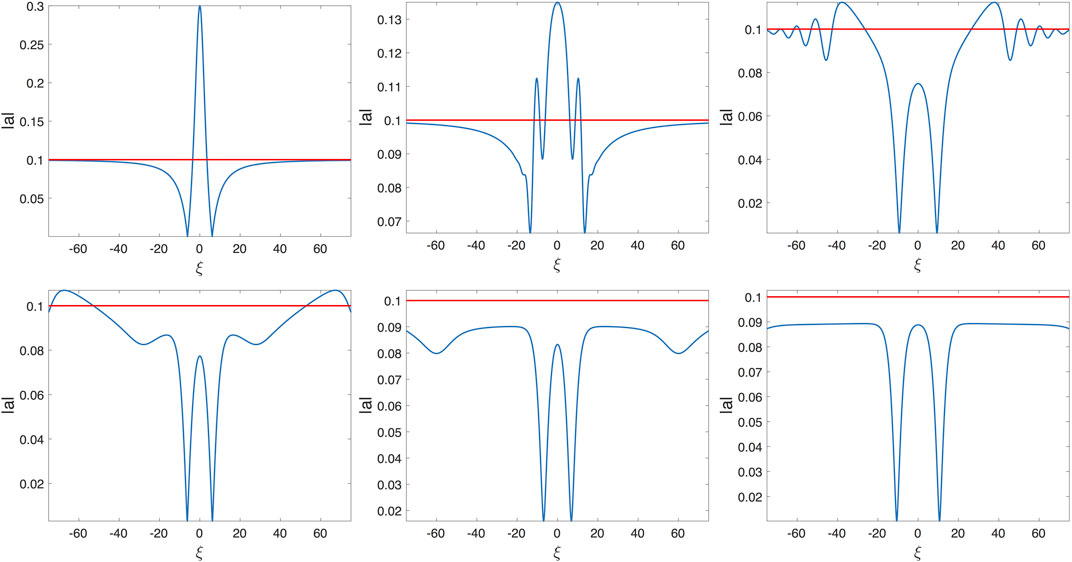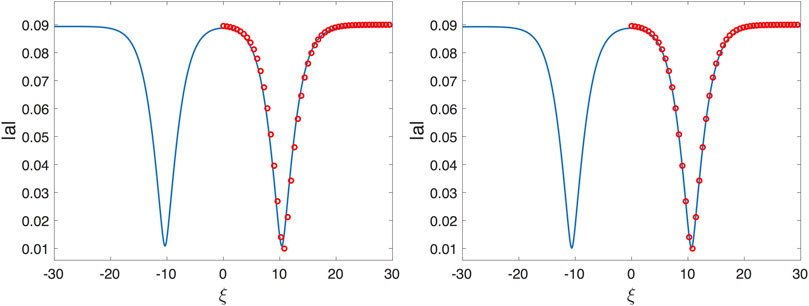
94% of researchers rate our articles as excellent or good
Learn more about the work of our research integrity team to safeguard the quality of each article we publish.
Find out more
BRIEF RESEARCH REPORT article
Front. Phys., 17 March 2021
Sec. Interdisciplinary Physics
Volume 9 - 2021 | https://doi.org/10.3389/fphy.2021.631993
This article is part of the Research TopicPeregrine Soliton and Breathers in Wave Physics: Achievements and PerspectivesView all 25 articles
In this Brief Research Report, we show, within the framework of the nonlinear Schrödinger equation in deep water and in the presence of vorticity (vor-NLS), that the Peregrine breather traveling at the free surface of a shear current of slowly varying vorticity may transform into gray solitons.
Within the framework of a fully nonlinear two-dimensional potential solver [4], computed the temporal evolution of a Stokes wavetrain with a small modulation. They found that the energy becomes focused, at the maximum of modulation, into a short wave packet of large amplitude they called a steep wave event (SWE). They showed that the Peregrine breather, which is an exact solution of the self-focusing nonlinear Schrödinger equation, was the most convenient approximation of the envelope of the SWE. Note that the Peregrine breather can be derived from the Kuznetsov-Ma breather and the Akhmediev breather in the limit of infinite temporal and spatial period (see [7]) [3]. suggested that the Peregrine breather may provide a useful and simple model for rogue wave events [1]. presented the first experimental observation of the Peregrine breather in a water wave tank. More recently [2], presented the first ever observation in a wave tank of dark solitons on the surface of water, so demonstrating the probable existence at the sea surface of dark solitons in finite depth for
We choose an Eulerian frame
In the case of a wave train propagating at the surface of a deep water flow of constant vorticity
with
with k the carrier wavenumber and g the gravitational acceleration.
[5] have compared both the linear intrinsic phase velocities and total energies of gravity waves in the presence of constant vorticity in finite depth and deep water and came to the conclusion that linear gravity waves in finite depth propagating at the surface of a water flow of constant vorticity behave like waves in infinite depth if

FIGURE 1. Dimensionless group velocity deviation between finite and infinite depths as a function of the dispersive parameter for several values of the dimensionless vorticity. In dimensionless terms, the units of acceleration and length are the acceleration of gravity g and
The focusing vor-NLS equation admits the Peregrine breather as solution
Note that
where

FIGURE 2. Dimensionless profiles of the Peregrine breather (left) and the gray soliton (right) for several values of the vorticity with
Within the framework of Eq. 1, we have performed a numerical simulation of the transformation of a Peregrine breather traveling at the free surface of a vortical water flow whose vorticity varies very slowly.
The parameter σ is chosen such that the average temporal variation of the vorticity along the ramp is of

FIGURE 3. Time evolution of the tranformation of the Peregrine breather into a two-grey soliton with

FIGURE 4. Gray soliton profiles at
Within the framework of the vor-NLS equation in infinite depth we have shown numerically that a Peregrine breather propagating at the free surface of a slowly varying vortical flow may generate gray solitons. The present simulation confirms in a different context the result of [2] on the existence of dark solitons on the surface of shallow water (
The original contributions presented in the study are included in the article/Supplementary Material, further inquiries can be directed to the corresponding author.
HH, Conceptualization of the project, Methodology, and formal analysis checking. MA, Formal analysis checking; Software design; Numerical simulations; Validation; Investigation; Visualization. YC, Conceptualization of the project and formal analysis checking. CK, Conceptualization; Methodology; Formal analysis; Investigation; Writing.
The authors declare that the research was conducted in the absence of any commercial or financial relationships that could be construed as a potential conflict of interest.
1. Chabchoub A, Hoffmann N, Akhmediev N. Rogue wave observation in a water wave tank. Phys Rev Lett (2011) 106:204502. doi:10.1103/PhysRevLett.106.204502
2. Chabchoub A, Kimmoun O, Branger H, Hoffmann N, Proment D, Onorato M, et al. Experimental observation of dark solitons on the surface of water. Phys Rev Lett (2013) 110:124101. doi:10.1103/PhysRevLett.110.124101
3. Dysthe KB, Trulsen K. Note on breather type solutions of the NLS as models for freak-waves. Physica Scripta (1999) T82:48–52. doi:10.1238/physica.topical.082a00048
4. Henderson KL, Peregrine DH, Dold JW. Unsteady water wave modulations: fully nonlinear solutions and comparison with the nonlinear schrödinger equation. Wave Motion (1999) 29:341–61. doi:10.1016/s0165-2125(98)00045-6
5. Kharif C, Abid M. Miles theory revisited with constant vorticity in water of infinite depth. Jmse (2020) 8(8):623. doi:10.3390/jmse8080623
6. Lo E, Mei CC. A numerical study of water-wave modulation based on a higher-order nonlinear schrödinger equation. J Fluid Mech (1985) 150:395–416. doi:10.1017/s0022112085000180
7. Peregrine DH. Water waves, nonlinear schrödinger equations and their solutions. J Aust Math Soc Ser B, Appl. Math (1983) 25:16–43. doi:10.1017/s0334270000003891
Keywords: nonlinear schrödinger equation, water waves, Solitons, breather, vorticity
Citation: Hsu HC, Abid M, Chen YY and Kharif C (2021) Transformation of the Peregrine Breather Into Gray Solitons on a Vertically Sheared Current. Front. Phys. 9:631993. doi: 10.3389/fphy.2021.631993
Received: 23 November 2020; Accepted: 26 January 2021;
Published: 17 March 2021.
Edited by:
Amin Chabchoub, The University of Sydney, AustraliaReviewed by:
Miguel Onorato, University of Turin, ItalyCopyright © 2021 Hsu, Abid, Chen and Kharif. This is an open-access article distributed under the terms of the Creative Commons Attribution License (CC BY). The use, distribution or reproduction in other forums is permitted, provided the original author(s) and the copyright owner(s) are credited and that the original publication in this journal is cited, in accordance with accepted academic practice. No use, distribution or reproduction is permitted which does not comply with these terms.
*Correspondence: C. Kharif, a2hhcmlmQGlycGhlLnVuaXYtbXJzLmZy
Disclaimer: All claims expressed in this article are solely those of the authors and do not necessarily represent those of their affiliated organizations, or those of the publisher, the editors and the reviewers. Any product that may be evaluated in this article or claim that may be made by its manufacturer is not guaranteed or endorsed by the publisher.
Research integrity at Frontiers

Learn more about the work of our research integrity team to safeguard the quality of each article we publish.